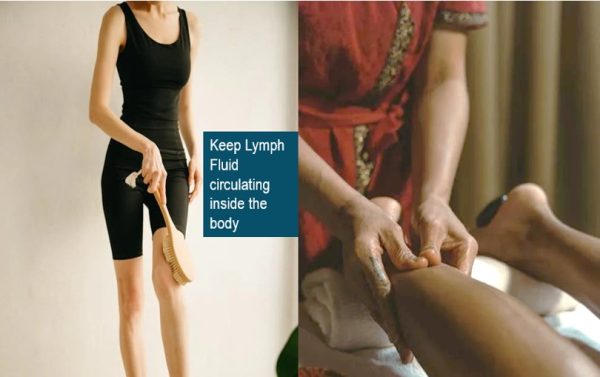
Keep Lymph Fluid Circulating For Good Health
Lymph fluid, also known as lymph, is a clear, colorless fluid that flows through the lymphatic system, which is part of the immune system. Lymph is composed primarily of water, proteins, white blood cells-especially lymphocytes, and waste products.
Functions of Lymph Fluid:
- Transporting WBC: Lymph carries lymphocytes, which help fight infections and play a critical role in the body’s immune response.
- Removing toxins and Waste: It helps remove cellular waste, bacteria, and other debris from tissues.
- Absorbing Fats: Lymph absorbs fats and fat-soluble vitamins from the digestive system and transports them to the bloodstream.
- Maintaining fluid balance: It helps return excess tissue fluid to the bloodstream, preventing swelling and maintaining the body’s fluid balance.
How lymph circulates in our body? Lymph fluid circulates through lymph vessels and passes through lymph nodes, which filter the fluid and remove harmful substances like bacteria and cancer cells. Unlike the circulatory system, the lymphatic system does not have a pump (like the heart); lymph moves through the body due to muscle contractions, breathing, and the presence of valves in the lymphatic vessels that prevent backflow.
If lymph fluid does not circulate properly, it can lead to a condition called lymphedema. The lymphatic system is a crucial part of the immune system, responsible for removing waste, toxins, and excess fluid from tissues, and transporting lymph—a fluid containing infection-fighting white blood cells—throughout the body.
Consequences of poor lymph circulation:
Swelling (Edema): When lymph fluid cannot circulate properly, it accumulates in the tissues, causing localized swelling, usually in the arms or legs. This swelling can be painful and may become severe over time.
Increased risk of infections: Since lymph fluid contains white blood cells that help fight infections, poor circulation can weaken the immune system. The stagnant fluid becomes a breeding ground for bacteria, leading to frequent skin infections (like cellulitis) or more serious infections.
Tissue damage and fibrosis: Chronic lymphedema can cause tissues to harden and thicken in a process known as fibrosis. This can reduce mobility and make the affected area more prone to injuries and infections.
Discomfort and pain: Lymph fluid buildup can cause a feeling of heaviness, tightness, or aching in the affected area. The skin may feel tight, and the swelling may lead to pain, reduced range of motion, and difficulty with movement.
Skin changes: The skin over the swollen area may become tight, thick, and rough. Over time, skin changes such as discoloration, warts, or leakage of lymph fluid through the skin can occur.
Impaired wound healing: Poor lymphatic circulation can slow down the healing process of cuts, wounds, or surgical incisions due to reduced immune response and poor drainage of toxins and waste products.
Psychological impact: Chronic conditions like lymphedema can affect mental health, leading to feelings of frustration, anxiety, depression, or social withdrawal due to physical discomfort and changes in appearance.
Draining lymph fluid naturally can be achieved through various methods that promote the healthy functioning of the lymphatic system.
1. Exercise: Regular exercise, especially activities that involve jumping or bouncing (like rebounding or jumping rope), can help stimulate lymph flow. Walking- A daily walk can also encourage lymph movement.
2. Hydration: Drink the right amount of water throughout the day to maintain proper hydration, which is essential for lymphatic health.
3. Dry brushing: Use a natural bristle brush to gently brush your skin in long, upward strokes towards the heart. This can stimulate lymph flow and improve circulation.
4. Lymphatic massage: A gentle massage technique that encourages the movement of lymph fluids around the body. You can either see a professional or learn self-massage techniques.
5. Deep breathing: Practice deep diaphragmatic breathing exercises to help move lymph fluid through the chest area. Learn Yogic Pranayama breathing exercises to keep lymph fluid moving in the body.
6. Healthy diet: Eat a balanced diet rich in fruits, vegetables, and lean proteins. Include foods that support lymphatic health, such as citrus fruits, leafy greens, nuts, seeds, and omega-3 fatty acids.
7. Herbal teas and supplements: Some herbs are believed to support lymphatic health, such as echinacea, cleavers, and red clover. Always consult with a healthcare provider before starting any new supplements.
8. Hydrotherapy: Alternating between hot and cold showers can stimulate lymphatic circulation. Morning and night showers before going to bed will help stimulate lymphatic circulation.
9. Elevate legs: Lying down with your legs elevated above your heart can help drain lymph fluid from the lower body. Practicing legs up the wall yoga pose is beneficial for heart health.
10. Compression garments: Wearing compression stockings can help encourage the flow of lymphatic fluid in legs and supports legs.
11. Avoid tight clothing: Avoid wearing tight-fitting clothes that can restrict lymph flow. Tight clothing around your stomach and groin area is not good for lymphatic fluid easy flow.
12. Reduce toxins: Minimize exposure to environmental toxins and maintain a healthy liver function to support the lymphatic system.
Incorporating these practices into your daily routine can support lymphatic drainage and overall health. If you have specific health concerns or conditions, it is always best to consult with a healthcare professional before starting any new health regimen.
Image credit: Photo by Tima Miroshnichenko: https://www.pexels.com/photo/close-up-shot-of-a-person-doing-a-massage-6188036/ &Photo by Yaroslav Shuraev: https://www.pexels.com/photo/a-woman-in-black-tank-top-and-black-shorts-holding-brown-wooden-brush-6810844/
Author: Sumana Rao | Posted on: September 3, 2024
« Cold And Heat Pads – When To Use? Tips To Prevent Charley Horse Or Calf Muscles Cramp »






















Write a comment